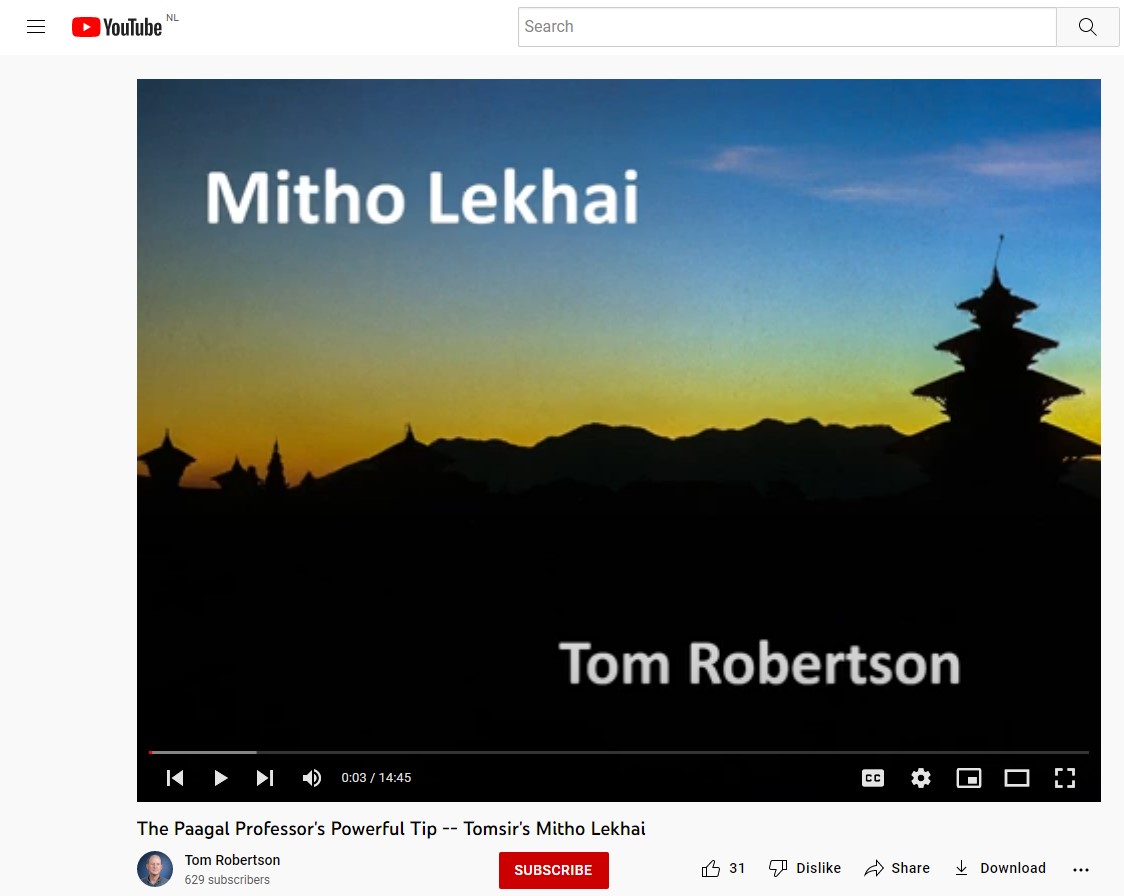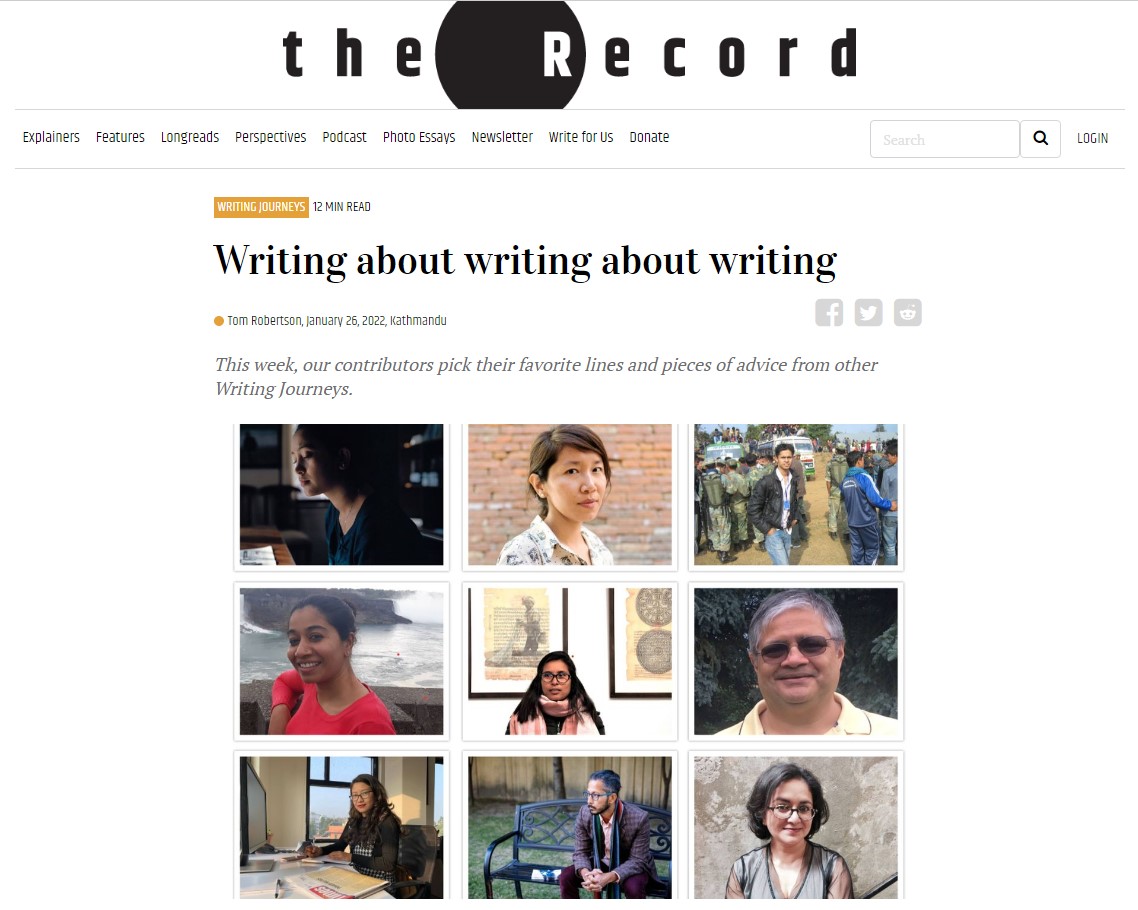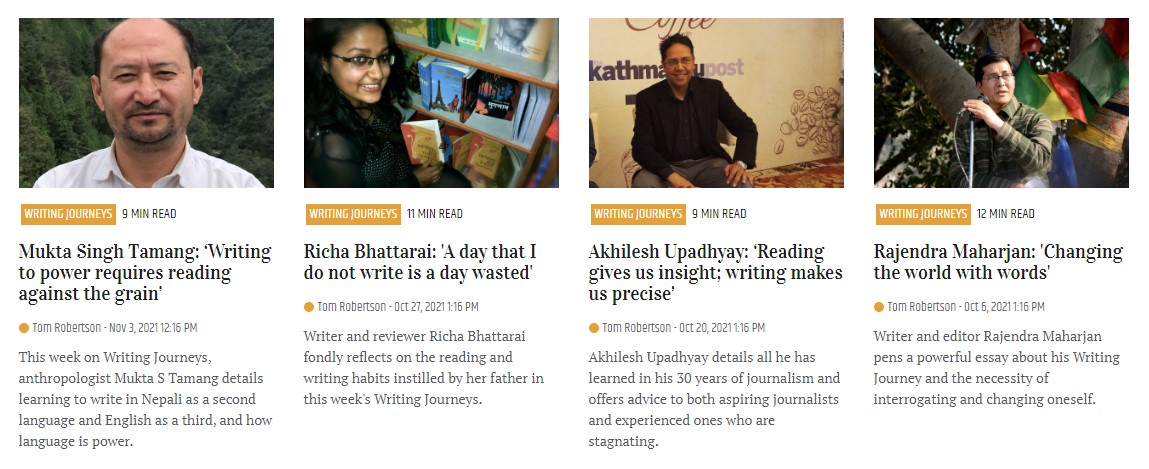Teaching the Craft of Writing: An Interview with Tom Robertson
Tom Robertson is a scholar at Kathmandu University in Nepal. Trained in history, Tom’s academic research focuses on international development, with a special emphasis on the environment. The following is a conversation about the mechanics of writing well. During COVID-19, Tom launched two initiatives aimed at teaching practical writing techniques, particularly in nonfiction genres. The first of these initiatives is a free series of YouTube videos called Mitho Lekhai. Each video in the series presents tips for clear and effective writing. The second initiative is called “Writing Journeys,” a series of essays by prominent Nepali journalists and authors about the craft of writing. While these initiatives were particularly tailored to the context of Nepal, the tips and strategies they offer will be useful for students, academics, and professionals working in any language.
Can you tell us a bit about your academic background? When did you first start researching and working in Nepal?
I'm a historian, and I trained at the University of Wisconsin, Madison, where I finished my PhD in 2005. I first came to Nepal over thirty years ago as an undergraduate and later as a member of the Peace Corps. Throughout graduate school, I wrote a dissertation that related to South Asia but not to Nepal, and as a second project I wanted to write about American History but also about Nepal. The overlap I landed on was U.S. development projects in Nepal. The most important of those projects was malaria and its eradication.
We met around 2018, and at that time, you were leading the Fulbright office in Kathmandu. Fulbright is centrally concerned with education, so how did you first get interested in educational practice, both in general and in Nepal particularly?
Well, I wanted to live in Nepal and Fulbright was one way to do so. I have to say that I have always been interested in academic mentoring, and Fulbright was a way to do that. I really loved working with grantees. They are such creative, independent people. It is so much fun to help them with their journeys.
It wasn’t long after we met that I started seeing posts about a YouTube series you initiated called Mitho Lekhai. 1 Can you describe that series and what led you to create it?
The series is instructional videos in Nepali language about how to write nonfiction. I give lots of examples, mostly in English, but I speak in Nepali with some English mixed in. I talk about topics like paragraphs, essays, sometimes I have a whole video on verbs. So I pick different subjects that I think are important, useful stepping stones for students and professionals. The videos are aimed at professionals and college-aged people, but I think some talented high school students can also utilize them. These videos truly work at all levels.
I'll tell you what led me to create it. Some friends asked me to do an online workshop with them about writing during the COVID-19 lockdown. They had a lot of things to say – these were professionals, but they had never had training in how to write, so that’s what they were looking for. We met weekly and picked a different topic each time to focus on. Eventually, I began to anticipate what we would be talking about and what I would want to say. Often, the topics were things I had taught many times before. Although I had certain materials that I knew I wanted to say, I decided to videotape and share them with my friends in advance of this meeting so that I could also make them available to other people.
In Nepal, there is very little instruction about writing in schools, for all ages. As a result, students graduate and become professionals without having learned the basics of how to write. I became very aware of that during my time at Fulbright. I saw Nepal's best students, who struggled with writing. In large part, this was due to the fact that writing is super difficult and everyone struggles with writing, but it is even harder if you’ve never gotten any instruction. And there were certain learnable, discrete skills that I could focus on, such as paragraphs and organization, while mixing English and Nepali. Due to the COVID-19 lockdown we were in, my circle enjoyed this instructional platform and I was motivated to make more.

Fig. 1: Screenshot of instructional video in the Mitho Lekhai series. (Source video by Tom Robertson. Available at https://www.youtube.com/watch?v=OhqBVyFRQBg)
You delivered your videos primarily in Nepali. Were there any things in particular that were challenging in that act of translation? Was it difficult to take tips that emerged in an English context for you and put them into a Nepali context?
That's an interesting question. I decided to make the videos mostly in Nepali because my experience is that most people in Nepal are more familiar and comfortable in Nepali. I wanted to make sure that they understood every word I was saying. Plus, it's also the case that Nepalis like listening to foreigners speak Nepali, so that adds a little added appeal to the videos. It makes them a little more interesting. I mix in English, so that anyone who wants to practice English can do that, too. To answer your question, I don’t think there was anything that difficult to translate. Some of the examples I used – the actual language translation of the examples – were a little complicated, but not the writing principles.
I will say, however, that there are different cultures of writing. There’s a culture of writing in Nepal that’s different from the culture of writing in the United States or most of Western Europe. For example, in some writing cultures, people are not as direct, concise, and to the point in the way that gets hammered into pupils in the United States. That is a common obstacle that my friends, my students, and I need to get around. I try to avoid saying that one style is right and one is wrong, but I do point out the differences and let my students, friends, and workshop participants assess and decide what they want to do. I think that they should learn both ways, and then they can choose and use whatever method they think is appropriate.

Fig. 2: Screenshot of the "Writing Journeys” series in The Record. (Available at https://www.recordnepal.com/)
What convinced you that writing was the subject you wanted to focus on? To put it in a pithy way: Why does writing well matter so much?
First off, it was Nepalis who approached me. They came to me and said, “Hey, we need this. We have things to say – we are experts in our fields – but we don’t have the tools with which to say them.” That meant specifically writing skills: how craft effective sentences, how to make paragraphs, how to pull things together in an essay form. But when they approached me, I was interested in this. I immediately recognized this as something I wanted to do because of my own experience. Growing up, I felt like words didn’t come easily to me, that writing was something that was hard, really difficult, maybe even a little unnatural for me. It certainly didn’t come easily, but then I realized, through the benefit of some really excellent teachers, that there are certain skills that you can learn. There are certain steps that demystify the process and take it from some sort of magical creation of words to a step-by-step process in a lot of cases. There are lots of little learnable skills that are out there, and those skills really helped me.
Why does writing matter? Writing matters because we can't understand anybody without an intervention through words, and most often through written words. There are so many people that have so much to say, but they don’t get heard because their words are a jumble, or they're not clear, or they’re disorganized. Writing is crucial in every field – not just fields like history or social sciences, but in other more technical fields as well. I taught at a technical university in the United States for ten years. What distinguishes those who move ahead from those who don’t is often the ability to think clearly and to read and write effectively.
What you’re doing in these videos is getting into the “nitty-gritty” elements of writing. What are some of the tips you focus on in the videos and in general advice that you give to students?
Active versus passive voice, short sentences, short paragraphs. I also emphasize being concrete as opposed to abstract – to use specific, clear, and concrete language. I like to give examples of that. Overall, though, the main point of all of the videos and all of my teaching on writing is that there are learnable skills. Writing can be studied, it can be learned, and you can make improvement. I don’t believe in “natural” writers. There are people that have a lot of practice, and so things come more easily to them, but it’s because they’ve had lots of practice. Just like volleyball or playing the violin, the more practice you get, the more you improve. This is something that I repeat again and again throughout my videos because I'm afraid that in Nepal, people think that learning the skills to write is not possible and that being a good writer is innate. My understanding is that it's just the opposite, and focusing on these specific skills – the “nitty-gritty” – is the way to do it.
This concern with effective and economical writing migrated over to your collaboration with The Record, a long-form journalism outlet in Nepal. You launched a series there in 2021 called “Writing Journeys.” 2 What is “Writing Journeys,” and how did it come to be?
“Writing Journeys” is a collection of articles by well-known Nepali writers who concentrate, although not exclusively, on nonfiction writing. It's a collection of essays that they write about their own writing journeys – about how they learned to write, about who taught them, about key discoveries they made in the process, about favorite breakthrough works that helped them get better-known to the larger public. I wanted Nepalis to hear from other Nepalis that writing is something that is learnable, that there are specific skills. These writers thus explained their little tips and the steps that helped them in their writing. They do it in storytelling fashion. It’s really just a collection of stories about writing – about what makes it hard, about how improvement can be made, about what time of day they write, about what conditions they write in, about what joys writing brings them. It’s all those sorts of things.
How did you select the Nepali authors and writers for the series? Were they eager and enthusiastic to join the project?
I mostly looked for nonfiction writers because fiction writers in Nepal have gotten a little more attention. I wanted to focus on a different kind of writing – not just fiction, but everyday writing (e.g., letters, essays, reports, journalism). I felt those topics had gotten almost no attention, and there were these great writers around. I approached them, starting with people I knew in the beginning. Then I also relied on recommendations from friends. Not everybody said yes, but most did. Sometimes, I had to explain what I was looking for, especially at the beginning. In general, people liked the process. They liked doing it. They feel that the writing assignment took them to places, took them to memories that they hadn't visited in a while, and it helped them pull together some experiences and reflect on their own evolution as writers. For the most part, people liked the process, and I liked that they liked it. We also did lots of versions. Nobody was able to publish something on the first draft. Even well-known writers were asked to do sometimes three or four edits, which was a very productive and fun process for me and for them, too.

Fig. 3: Screenshot of four "Writing Journeys” essays in The Record. (Available at https://www.recordnepal.com/)
We may have given the false impression that your primary occupation is teaching writing, when in fact you have your own long history of scholarship in Nepal and South Asia. I wanted to give you an opportunity to tell us what you have been working on at the moment in terms of your own research and teaching.
I'm working on writing up a lot of research I've done over the past decade related to the malaria eradication project in the 1950s and 1960s. The United States was very involved in that – a number of Americans were involved. As an outgrowth of the malaria project, I have also done a lot of work in the Chitwan district in south-central Nepal. I'm finishing an article on the origins of Chitwan National Park and on the role of grasslands in that park. It’s about the interactions of people with grasslands over the decades and centuries, and it’s about how that history was often forgotten and the problems that forgetting that history caused for the national park. So, I have a number of environmental history writings that I need to get done.
I also have done a lot of writing recently about Kathmandu. The city has changed so dramatically in the last five decades. There are a lot of fascinating historical stories that need to be told, so I’m trying to work on some of those as well.
What other resources would you recommend for students eager to improve their writing skills?
There is a classic book by William Zinsser called On Writing Well. 3 Parts of it are a little dated, but parts of it are great. I use it with my students and workshop participants all the time. Another more recent book on writing is Roy Peter Clark's Writing Tools, 4 which I think is really easy to read and really smart. He has great examples, and he summarizes his points in an effective way.
If you had to give one piece of advice to budding writers, particularly those seeking to write in a second or third language, what would it be?
My all-time favorite tip is: short, focused paragraphs. Short is important, but what is even more important is to make your paragraphs focused. Know what your paragraph is about and cut, cut, cut anything that doesn’t belong. When I learned this, my writing improved dramatically almost overnight. A professor made the suggestion to me at one point that I try and limit my paragraphs to about five sentences. What that forced me to do is get straight to the point. At first, I thought that would be easy – “Oh, I don’t have to write as much!” – but actually it’s a lot harder. I have to really decide what to put in the paragraph and what not to put in the paragraph. That makes me decide, what is it really about? And once you do that, you can explain the main point in the first sentence, and that just makes it so much easier for readers to figure out what you’re driving at.
Before I learned how to write short and focused paragraphs, I would have long, sprawling paragraphs that must have been a tough slog for my audience. So that’s my favorite advice: keep what you’re writing short, keep it concise, keep it to the point. That makes reading easier. It makes getting through your writing easier on readers. As writers, we tend to forget about our readers, but they have a tough job and we need to make it easier for them.
This transcript has been heavily edited and abridged. The original interview includes a wealth of further details and discussion. To hear the full conversation, listen and subscribe to The Channel podcast: https://shows.acast.com/the-channel
-----
The Slate is devoted to pedagogy and educational praxis, both in and beyond the classroom. This section is meant to be a space for educators and researchers to explore the debates, practices, challenges, and opportunities of 21st-century education. The Slate can take many forms, encompassing everything from personal reflections to practical resources for educators (e.g., syllabi, field exercises, etc.), from critical essays on traditional education to experimental teaching strategies. With this section, we seek perspectives that decolonize conventional curricula and pedagogies. Through socially and civically engaged approaches, the section aims to foster alternative models for education that are grounded in contemporary experience and which strive towards greater accessibility, innovation, and critical engagement.